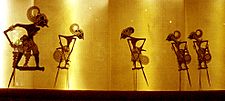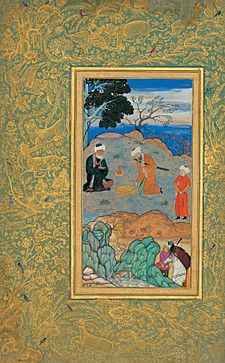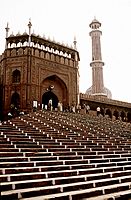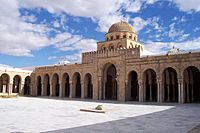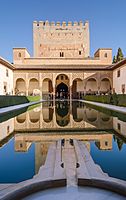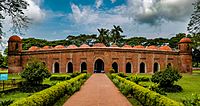Islamic culture facts for kids
Islamic culture and Muslim culture are all about the ways of life, traditions, and art that are common among people who have been historically connected to Islam. In the beginning, Muslim culture was mostly shaped by Arab, Byzantine, Persian, and Levantine influences. This was during the early times of the Rashidun, Umayyad, and Abbasid empires.
As the Islamic empires grew quickly, Muslim culture took in and shared ideas with many other cultures. These included Persian, Egyptian, North Caucasian, Turkic, Mongol, Indian, Bangladeshi, Pakistani, Malay, Somali, Berber, Indonesian, and Moro cultures. Islamic culture generally includes all the practices that have grown around the religion of Islam. How Islamic beliefs are used can be different in various cultures and traditions.
Contents
Language and Literature in Islamic Culture
Islamic literature includes many writings from different languages and regions.
Arabic Literature
Arabic literature means all the writing, both stories and poems, created by writers in the Arabic language. The Arabic word for literature is "Adab". This word also means good manners, culture, and learning.
Arabic literature started around the 5th century. Before that, only small pieces of written Arabic existed. The Qur'an, which is the holy book of Islam, is seen by many as the most beautiful piece of writing in Arabic. It had a huge and lasting impact on Arabic culture and its literature. Arabic literature became very strong during the Islamic Golden Age. It is still active today, with poets and writers across the Arab world and beyond finding success.
Persian Literature
Persian literature includes spoken stories and written texts in the Persian language. It is one of the oldest literatures in the world, going back more than 2,500 years. Its roots are in Greater Iran, which includes modern-day Iran, Iraq, Syria, Afghanistan, the Caucasus, and Turkey. It also includes parts of Central Asia and South Asia where Persian was once the main or official language.
For example, Rumi, a very famous Persian poet, was born in what is now Afghanistan or Tajikistan. He wrote in Persian and lived in Konya, which was the capital of the Seljuks in Anatolia. The Ghaznavids took over large areas in Central and South Asia. They made Persian their court language. So, Persian literature comes from many places like Iran, Mesopotamia, Azerbaijan, the wider Caucasus, Turkey, parts of Pakistan, Bangladesh, India, and Tajikistan.
Some people also include works written by ethnic Persians in other languages, like Greek and Arabic, as Persian literature. Also, not all literature written in Persian was by ethnic Persians. Turkic, Caucasian, and Indian poets and writers also used Persian in areas influenced by Persianate cultures.
Persian literature is seen as one of the world's great literatures. Goethe called it one of the four main types of world literature. Its roots are in older languages like Middle Persian and Old Persian. The oldest known Old Persian writing is from 522 BCE, the Behistun Inscription from the Achaemenid period. Most of the Persian literature we have today comes from after the Arab conquest of Persia around 650 CE.
After the Abbasids came to power (750 CE), Iranians became important writers and poets in the Arab empire. New Persian language literature grew and became popular in Khorasan and Transoxiana. This was partly because early Iranian ruling families, like the Tahirids and Samanids, were based there.
Famous Persian poets like Ferdowsi, Sa'di, Hafiz, Attar, Nezami, Rumi, and Omar Khayyam are also well-known in the West. They have influenced literature in many countries.
Indic Literature
For a thousand years, starting with the Ghaznavids invading India, the Persian-Islamic culture of the eastern Islamic world began to influence Indian culture. Persian was the official language of many Indian empires, such as the Ghaznavids, the Delhi Sultanate, the Bengal Sultanate, the Deccan Sultanates, and the Mughal Empire. Persian art forms in literature and poetry, like ghazals, have greatly shaped Urdu and other Indian literature.
More Persian literature was actually created in India than in Iran. Even in the 20th century, Allama Iqbal chose Persian for some of his main poems. The first Persian language newspaper was also printed in India, as printing machines were first used there.
In Bengal, Muslim writers explored different topics using Islamic stories and epics. These included culture, how the universe works, love, and history. Starting with Shah Muhammad Saghir in the 14th century, Muslim writers helped the Bengali language grow for over 600 years. Rulers often supported them. The early 20th century brought a new time for Bengali Islamic literature. Its most famous poet, Kazi Nazrul Islam, wrote strongly against colonialism and unfairness. He also wrote a very popular collection of Bengali ghazals. Sultana's Dream by Begum Rokeya, an Islamic feminist, is one of the first works of feminist science fiction.
Turkish Literature
From the 11th century, more Islamic literature started to appear in Turkic languages. However, for many centuries, Persian remained the official language in Turkish-speaking areas. In Anatolia, when the Seljuks arrived, the use of Persian was strongly brought back. A part of the Seljuk family, the Sultanate of Rum, brought Persian language, art, and writing to Anatolia. They made Persian the official language of their empire.
The Ottomans, who came after them, continued this tradition. Persian was the official language of the court. For some time, it was also the official language of the empire. However, by the 15th or 16th century, Turkish became the common language among ordinary people. It had also started to form as a language as early as the 4th century.
After several centuries, Ottoman Turkish became a fully accepted language for literature. It could even be used for scientific writing. However, the number of Persian and Arabic words borrowed into these works sometimes reached 88%. Turkish was declared the official language of the Karamanids in the 17th century. But it did not become the official language in a wider area or larger empire until the Ottomans took power. With the rise of the Ottoman Empire, Ottoman Turkish became more important in both poetry and prose. By the early 18th century, it was the official language of the Empire. This was different from India, where Persian stayed the official and main literary language for both Muslim and Hindu states until the 19th century.
Islamic Art and Its Forms
Traditional public Islamic art usually does not show people or animals. Instead, it often uses plant shapes, like swirling arabesques. These are often mixed with Islamic calligraphy and geometric patterns. These styles are found on many things, from small ceramic or metal objects to large decorations on buildings, including mosques.
However, there is a long history in Islamic art of showing human and animal figures. This is especially true in paintings and small, unnamed relief figures used as decoration. Almost all Persian miniatures (unlike decorative illuminations) include figures, often many of them. The same is true for Arab, Mughal, and Ottoman miniatures. But miniatures in books or muraqqa albums were private works for rich people.
Large figures in monumental sculpture are very rare until recent times. Also, portraits showing real people (and animals) did not become common until the late 16th century in miniature painting, especially Mughal miniatures. Copies of the Qur'an and other holy texts have always been kept strictly free of such figures. But there is a long tradition of showing Muhammad and other religious figures in history and poetry books. Since the 20th century, Muhammad has mostly been shown with his face covered by a veil. Many older miniatures were repainted to follow this idea.
Showing Living Beings in Art
Some people who follow Islam believe it is forbidden to show living beings in art. This is called aniconism. This idea comes partly from the rule against worshipping idols. It also comes from the belief that only God can create living forms. The Quran does not clearly forbid showing any living being. However, it uses the word musawwir (maker of forms, artist) as a name for God.
The collection of hadith (sayings believed to be from the Islamic prophet Muhammad) has clearer rules against images of living beings. These sayings challenge painters to "breathe life" into their images and warn them of punishment on the Day of Judgment. Muslims have understood these rules in different ways over time and in different places.
Religious Islamic art usually does not have figures. Instead, it uses a lot of calligraphic, geometric, and abstract floral patterns. However, pictures of Muhammad (sometimes with his face hidden) and other religious figures are found in some old books from lands east of Anatolia, like Persia and India. These pictures were meant to help tell the story and not to break the rule against idol worship. But many Muslims still see such images as forbidden. In non-religious art in the Muslim world, pictures of human and animal forms were common in almost all Islamic cultures. But partly because of religious feelings against them, figures in paintings were often made in a stylized way. This led to many different decorative designs with figures.
Calligraphy: Beautiful Writing
Islamic calligraphy is the art of beautiful handwriting based on the Arabic alphabet. It is found in lands that share Islamic culture. This includes Arabic Calligraphy, Ottoman, and Persian calligraphy. In Arabic, it is called khatt Islami, which means Islamic line, design, or construction.
The growth of Islamic calligraphy is closely linked to the Qur'an. Chapters and parts from the Qur'an are a common and almost universal text used for Islamic calligraphy. However, Islamic calligraphy is not only for religious topics or objects. Like all Islamic art, it includes many different works created in various situations. Calligraphy is very important in Islamic art not just because figures are often avoided. It also shows how central the idea of writing and written text is in Islam. For example, it is said that Prophet Muhammad said: "The first thing God created was the pen."
Islamic calligraphy grew from two main styles: Kufic and Naskh. There are many different versions of each, as well as styles specific to certain regions. Islamic calligraphy has also been used in modern art since the time after colonialism in the Middle East. A newer style called calligraffiti mixes calligraphy with graffiti.
Islamic Architecture: Building Styles
Islamic architecture refers to the different styles of buildings connected to Islam. It includes both non-religious and religious styles from the early history of Islam until today. Early Islamic architecture was influenced by Roman, Byzantine, Persian, and other lands that Muslims took over in the 7th and 8th centuries. Further east, it was also shaped by Chinese and Indian architecture as Islam spread to Southeast Asia.
Later, it developed its own special features in building shapes and decorations. These decorations often use Islamic calligraphy and geometric or interwoven patterns. The main types of Islamic buildings for large or public use are: the Mosque, the Tomb, the Palace, and the Fort. From these four types, the ideas for Islamic architecture are taken and used for other buildings like public baths, fountains, and homes.
-
Northeast entrance to Delhi, India's Jama Masjid.
-
The Great Mosque of Kairouan in Tunisia is the oldest mosque in North Africa (started in 670 CE). It is still used for worship and is a very important Islamic building.
-
The fortress-palace of Alhambra, built in the 11th century, is a large and popular tourist spot.
-
Istanbul's Sultan Ahmed Mosque was finished in 1616.
-
The 15th-century Sixty Dome Mosque in Bangladesh is an example of the Bengal Sultanate architecture.
Key Features of Islamic Architecture
Islamic architecture can be recognized by these design elements. Many of these were taken from the first mosque built by Muhammad in Medina. Others were adapted from older churches and synagogues.
- Large courtyards often connected to a main prayer hall. This was first seen in the Masjid al-Nabawi.
- Minarets or towers. These were first used as watchtowers with torches, for example, in the Great Mosque of Damascus. The word "minaret" comes from the Arabic word nur, meaning "light." The oldest standing minaret is at the Great Mosque of Kairouan in Tunisia. It was built between the 2nd and 3rd centuries and is a grand square tower with three levels.
- A mihrab or niche on an inside wall. This shows the direction to Mecca. This might have come from older uses of niches for torah scrolls in Jewish synagogues or the Mehrab of Persian Mitraism culture, or the haikal of Coptic churches.
- Domes. The first time domes were used in Islamic buildings was in the 8th-century mosque of Medina.
- Use of iwans to connect different parts of a building.
- Use of geometric shapes and repeating art, like the arabesque.
- Use of decorative Arabic calligraphy.
- Use of symmetry, meaning things are balanced on both sides.
- Fountains for washing before prayer.
- Use of bright colors.
- Focus on the inside space of a building rather than the outside.
Theatre in Islamic Culture
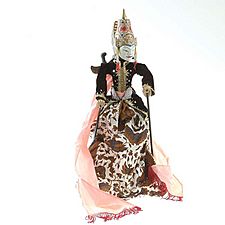
While theatre is allowed in Islam, it does not permit performances to show God, Muhammad, his companions, angels, or unseen religious matters.
The most popular types of theatre during the medieval Islamic world were puppet theatre and live passion plays called ta'ziya. Puppet theatre included hand puppets, shadow plays, and marionette shows. In ta'ziya, actors would re-enact events from Muslim history. Especially in Shia Islam, plays focused on the shaheed (martyrdom) of Ali's sons, Hasan ibn Ali and Husayn ibn Ali. Live non-religious plays were called akhraja. They were mentioned in medieval adab writings, but they were less common than puppet shows and ta'zieh theatre.
One of the oldest and most lasting forms of puppet theatre is the Wayang in Indonesia. Even though it mostly tells pre-Islamic stories, it is also important for Islamic epics, like the adventures of Amir Hamzah. Islamic Wayang is known as Wayang Sadat or Wayang Menak.
Karagoz, the Turkish Shadow Theatre, has influenced puppetry widely in the region. It is thought to have come from China through India. Later, the Mongols took it from the Chinese and brought it to the Turkish people in Central Russia. So, the art of Shadow Theatre came to Anatolia with Turkish people moving from Central Asia. Other experts say that shadow theatre came to Anatolia in the 16th century from Egypt. They say that when Yavuz Sultan Selim conquered Egypt in 1517, he saw shadow theatre performed at a party. Yavuz Sultan Selim was so impressed that he took the puppeteer back to his palace in Istanbul. There, his 47-year-old son, later Sultan Suleyman the Magnificent, became very interested in the plays and watched them often. This is how shadow theatre came to the Ottoman palaces.
In other areas, the shadow puppetry style known as khayal al-zill still exists. This name means 'shadows of the imagination'. This is a shadow play with live music, including drums, tambourines, and flutes. It also uses "special effects" like smoke, fire, thunder, rattles, and other sounds to make the audience laugh or shiver.
In Iran, puppets were known to exist much earlier than 1000 CE. But at first, only glove and string puppets were popular. Other types of puppetry appeared during the Qajar era (18th–19th century) as influences from Turkey spread. Kheimeh Shab-Bazi is a traditional Persian puppet show. It is performed in a small room by a musician and a storyteller called a morshed or naghal. These shows often happen alongside storytelling in traditional tea and coffee-houses (Ghahve-Khave). The dialogue is between the morshed and the puppets. Puppetry is still very popular in Iran. The touring opera Rostam and Sohrab puppet opera is a recent example.
The Royal Opera House in Muscat, Oman is seen as the first opera house that connects Islamic culture with classical music.
After the independence of Pakistan in 1947, strong nationalism based on religion affected theatre in both parts of the country. In East Pakistan (now Bangladesh), playwrights like Ibrahim Khan (1894-1978), Ibrahim Khalil (b. 1916), and Akbar ad-Din (1895-1978) emerged. These playwrights created plays about the Islamic history of the subcontinent and the Middle East. They praised past Muslim rulers and the history of the Pakistan Movement.
Dance in Muslim Cultures
Many types of dance are practiced in Muslim cultures. These include both religious dances and non-religious ones, like folk dances, court dances, celebration dances for weddings and festivals, and belly dancing.
Some Islamic scholars have given rules about dance based on gender. They say it is allowed for women in women-only settings, as often happens at celebrations. But they discourage men from dancing.
Most religious groups (tariqa) that are part of traditional Muslim religious life practice special forms of dance during dhikr ceremonies. Dhikr, meaning "recollection" (of God), is a type of worship that involves meditation. It is different from regular prayer. In dhikr, a person focuses all their senses and thoughts on God. They hope to gain maarifat (a deep, personal understanding of God) and experience mystical states. Dhikr can be done alone or with other followers under the guidance of a sheikh. It can involve silent meditation or repeating and imagining holy words, like the 99 names of God or phrases from the Qur'an. It can be done while sitting still or with rhythmic movements and controlled breathing. Traditional Islamic groups have developed various dhikr exercises. These sometimes include very detailed ritual dances with Sufi poetry and classical music.
Al-Ghazzali wrote about using music and dancing in dhikr and the mystical feelings it creates in worshippers. He also set rules for how these ceremonies should be done. He wrote about this in his short book on Islamic spirituality, The Alchemy of Happiness, and in his very important work, The Revival of the Religious Sciences. Al-Ghazzali stressed that music and dance are good for religious seekers, as long as their hearts are pure before they do these practices.
A famous example is the Mevlevi Order, started by Jalaluddin Rumi. This was the main Sunni group in the Ottoman Empire. Their sama ritual is known in the West as "the whirling dervishes". The Mevlevi order, its rituals, and Ottoman classical music were banned in Turkey for much of the 20th century. This was part of the country's effort to become more secular and "modern." The order's properties were taken, and its mosques were put out of its control. This greatly reduced its influence in modern Turkey. In 2008, UNESCO recognized the "Mevlevi Sama Ceremony" of Turkey as one of the Masterpieces of the Oral and Intangible Heritage of Humanity. This practice is now gaining interest again.
In Egypt and the Levant, the Mevlevi form of sama is called tannoura. Other Sufi orders have also adopted it with some changes.
The Chishti order is traditionally the main Islamic group in Afghanistan and the Indian subcontinent. It is the oldest of the major Sufi orders. It also practices forms of sama similar to the Mevlevis, as well as other types of devotional dance. This order is strongly linked to the growth of Hindustani classical music and semi-classical religious music like qawwali. Famous pioneers like Amir Khusrow helped this. The Chishti order remains one of the largest and strongest Muslim religious orders in the world. It has a huge influence on the spiritual life and culture of about 500 million Muslims in the Indian subcontinent.
Other examples of religious dance are found in the Maghreb, where it is linked to gnawa music. They are also found in Sub-Saharan Africa and South-East Asia. The Naqshbandi order, which is common among Iran's Sunni minority, is different because they do not use music and dancing in their dhikr.
Besides these religious dances, colorful dance processions traditionally happen in Muslim communities during weddings and public celebrations. These include Mawlid, Eid el-Adha, and so on. Many Islamic cultures have also developed classical dance forms. For example, in Mughal, Ottoman, Persian, and Javanese court cultures. There are also countless local folk and tribal dances, for instance, among Bedouin, Tuareg, and Pashto peoples. Other forms of dance are used for entertainment or sometimes healing, like belly dancing (mostly linked to Egyptian culture).
Even though tariqas and their rituals were a constant part of Muslim life for most of Islam's history, and helped spread Islam worldwide, their followers and influence have greatly decreased since the late 19th century. They have been strongly opposed by French and British colonial governments, and by Muslim modernists and secularists like Kemal Atatürk. In recent years, they have been strongly opposed by the fundamentalist Wahhabi group, which is supported by Saudi Arabia. In Saudi Arabia, most of the heritage linked to Sufism and tariqa was physically destroyed by the state in the 1930s. Wahhabi militant groups like ISIS and the Taliban repeatedly target dhikr ceremonies in terrorist attacks, especially in Egypt and Pakistan.
Music in Muslim Cultures
Many Muslims enjoy listening to music. The main historical area of Islam is Arabia, along with other parts of the Middle East, North Africa, and Central Asia. Because Islam is a religion with many cultures, the music of its followers is very diverse.
- Arab classical music
- Religious music in Iran
- Hindustani classical music
- Qawwali music
The Seljuk Turks, a nomadic group that became Muslim, conquered Anatolia (now Turkey). They later held the Caliphate as the Ottoman Empire. They also had a strong impact on Islamic music. See Turkish classical music.
Sub-Saharan Africa, India, and the Malay Archipelago also have large Muslim populations. However, these areas have had less influence on the different traditions of Islamic music compared to the heartland. For South India, see: Mappila Songs, Duff Muttu.
All these regions were connected by trade long before the Islamic conquests in the 7th century and later. It is likely that musical styles traveled along the same trade routes. However, since we don't have recordings, we can only guess about the music of these areas before Islam. Islam must have had a great influence on music. It brought together vast areas under the first caliphs and made trade easier between distant lands. Certainly, the Sufis, who were groups of Muslim mystics, spread their music far and wide.
See articles on Eid ul-Fitr, Eid ul-Adha, Ashurah (see also Hosay and Tabuik), Mawlid, Lailat al Miraj, and Shab-e-baraat.
Family Life in Muslim Cultures
In a Muslim family, the birth of a child involves some religious ceremonies. Right after birth, the words of Adhan are whispered into the child's right ear. On the seventh day, the aqiqa ceremony is performed. In this ceremony, an animal is sacrificed, and its meat is given to the poor. The child's head is also shaved, and money equal to the weight of the child's hair is given to the poor. Besides providing basic needs like food, shelter, and education, parents or older family members also teach children good morals, religious knowledge, and religious practices.
Marriage, which is the basis of a Muslim family, is a civil contract. It involves an offer and acceptance between two willing people in front of two witnesses. The groom must pay a bridal gift (mahr) to the bride, as stated in the contract. Since Muslims come from many different backgrounds, including 49 Muslim-majority countries and large minorities worldwide, there are many variations in Muslim weddings. Generally, in a Muslim family, a woman's main role is in the home, and a man's role is in the outside world. However, in real life, this separation is not always so strict.
Certain religious rituals are performed during and after the death of a Muslim. Those near a dying person encourage them to say the Shahada. Muslims want their last words to be their declaration of faith. After death, the body is properly washed by people of the same gender. Then it is wrapped in a three-piece white cloth called kafan. The body is placed on a bier and first taken to a mosque. There, a funeral prayer is offered for the dead person. Then, it is taken to the graveyard for burial.
Etiquette and Diet in Islam
Many practices fall under adab, which means Islamic etiquette. This includes greeting others with "as-salamu 'alaykum" ("peace be upon you"). It also means saying bismillah ("in the name of God") before meals. Muslims also use only their right hand for eating and drinking.
Islamic hygiene practices mainly focus on personal cleanliness and health. Circumcision of male children is also practiced in Islam. Islamic burial rituals include saying the Salat al-Janazah ("funeral prayer") over the washed and wrapped dead body. Then, the body is buried in a grave.
Muslims have rules about what they can eat. Forbidden foods include pork products, blood, carrion (dead animals), and alcohol. All meat must come from a herbivorous animal that was killed in the name of God by a Muslim, Jew, or Christian. The only exception is game that one has hunted or fished for oneself. Food that is allowed for Muslims is known as halal food. Islam forbids eating flesh, drinking blood, and certain meats, like pork.
Martial Arts in Muslim Countries
- Pahlavani – Iran
- Yağlı güreş – Turkey
- Gatka – Pakistan
- Kurash – Central Asia
- Istunka – Somalia
- Nuba fighting – Sudan
- Tahtib – Egypt
- Laamb Wrestling – Senegal
- Dambe – Nigeria
- Boli Khela – Bangladesh
- Lathi Khela – Bangladesh
- Sqay – India
- Pencak silat – Indonesia
- Bakti Negara – Indonesia
- Perisai Diri – Indonesia
- Kuntao – Indonesia
- Tarung Derajat – Indonesia
- Silat – Indonesia
- Silat Melayu – Malaysia
- Seni Gayung Fatani – Malaysia
- Seni Gayong – Malaysia
- Tomoi – Malaysia
- Lian padukan – Malaysia
- Furusiyya – West Asian
See also
 In Spanish: Cultura musulmana para niños
In Spanish: Cultura musulmana para niños
- Cultural Muslim
- Islamicate
- Islam in South Asia
- Islamic advice literature
- Islamic literature
- Muslim meme


